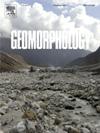The fluvio-deltaic interaction on river channel morphodynamical equilibrium in the lower Yellow River
IF 3.1
2区 地球科学
Q2 GEOGRAPHY, PHYSICAL
引用次数: 0
Abstract
Upstream river channel adjustments exhibit complex responses to changes in base level, particularly those induced by delta river channel avulsions. While this phenomenon has been studied, the equilibrium of river channels under the influence of base level changes and fluvial transport remains unclear. The Yellow River delta, known for frequent channel avulsions, exerts a time-varying impact on upstream river channel dynamics. In this study, we employed multi-source data to quantify the overall effect of delta evolution on upstream river channel changes in the lower Yellow River. We analyzed water level fluctuations at a discharge of 3000 m3/s (a representative near-bankfull discharge) from five hydrological stations over the period from 1951 to 1990. The water levels at all five cross-sections showed an overall rising trend with fluctuations. However, the trends at different stations during the same period were not synchronous, indicating that the river channel bed elevation did not rise or fall uniformly across the entire lower Yellow River. To explore this further, we conducted lagged linear regression to determine how river channel changes responded to delta propagation both downstream and upstream. The regression results showed no lag in water level changes at the five hydrological stations in the downstream direction. However, in the upstream direction, the water levels at Huayuankou, Gaocun, Aishan, and Luokou demonstrated a maximum delayed response of up to 8 years to changes at the Lijin station. This suggests that river channel adjustments can experience up to an 8-year delay in response to flow-sediment regimes at Lijin, likely due to the backwater effects of deltaic evolution. The point of transition where lagged regression coefficients in both the downstream and upstream directions converge near Aishan was identified as the upper boundary of the delta backwater effect. At this location, the downstream influence of fluvial processes and the upstream influence of delta backwater equilibrate. This point is situated approximately 500 km from the Xiaolangdi Dam and 250 km from Lijin. Our findings offer new insights into the ongoing debate regarding river channel adjustments in the lower Yellow River, under the dual influence of fluvial sediment transport and delta backwater effects.
求助全文
约1分钟内获得全文
求助全文
来源期刊

Geomorphology
地学-地球科学综合
CiteScore
8.00
自引率
10.30%
发文量
309
审稿时长
3.4 months
期刊介绍:
Our journal''s scope includes geomorphic themes of: tectonics and regional structure; glacial processes and landforms; fluvial sequences, Quaternary environmental change and dating; fluvial processes and landforms; mass movement, slopes and periglacial processes; hillslopes and soil erosion; weathering, karst and soils; aeolian processes and landforms, coastal dunes and arid environments; coastal and marine processes, estuaries and lakes; modelling, theoretical and quantitative geomorphology; DEM, GIS and remote sensing methods and applications; hazards, applied and planetary geomorphology; and volcanics.
 求助内容:
求助内容: 应助结果提醒方式:
应助结果提醒方式:


